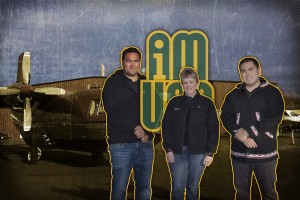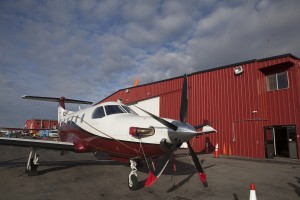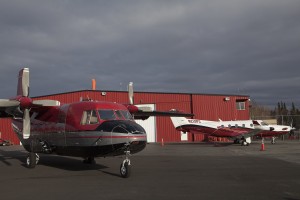Community Spotlight: Ryan Air
by J. Besl |

Ben Ryan, Starr Shanley and Lee Ryan at Ryan Air's Anchorage hangar. The company has dozens of UAA alumni in the air and on the ground at seven hubs across Western Alaska. (Photo by Philip Hall/University of Alaska Anchorage)
Flying in the Bush is a bit different than in the rest of the country. Checked bag fees get complicated when you're driving a small car into the cargo hold. Fellow passengers could include several Icelandic ponies or-in one unique case-a stranded walrus.
Ryan Air has been serving Bush communities for over 50 years, supplying nearly anything they can fit in a plane to outlying villages reliant on air transportation. Dividend season makes October their busiest time of year, as they ship PFD purchases-like snowmachines, microwaves, boats, refrigerators and beds-out to all of Western Alaska. That's part of life in the remote villages and Ryan Air-with deep family roots in the area-is committed to providing for their network of communities.
"Primarily the reason we went into business was to serve the people of the Bush," explained Lee Ryan, vice president of Ryan Air and 2004 graduate of UAA. "My great-grandpa hauled mail between Unalakleet and Kaltag; he would dogsled in winter and walk it in the summer. My grandpa grew up watching that and thought 'there's a better way to serve people.'"
Enter the airplane. Wilfred Ryan Sr.-Lee's grandfather-grew up in Unalakleet, where he saw his first plane landing as a child. He was so enamored with flight that he and a friend hatched a plan to eat rabbit fur until they were sick, forcing a plane to evacuate them for medical attention. It didn't work. But he did earn his private pilot's license a decade later in 1947 and soon after that founded Unalakleet Air Taxi in 1953. Wilfred's first route-Unalakleet to Kaltag-covered the distance of his father's original mail route in a fraction of the time, and the company slowly expanded service across the surrounding Yukon area.
Today, the company-now known as Ryan Air-serves 73 villages out of seven hubs, employing over 100 people across Western Alaska. The staff includes a heavy representation of Ryans-Wilfred had nine children and dozens of grandchildren-but there's an equally strong contingent of UAA alumni anchoring the company throughout the state.
Tales from the cargo hold

One of Ryan Air's Pilatus PC-12s at the Anchorage office near Kincaid Park. (Photo by Philip Hall/University of Alaska Anchorage)
Ryan Air operates out of Anchorage from a hangar on the edge of Kincaid Park. Their staff and planes, however, are scattered across the hub cities of Western Alaska. The Ryan Air fleet includes six-seater Cessna 207s, a brand-new Cessna 208, sleek single-engine Pilatus PC-12s and bulky CASA C-212s for the heavy lifting. The company's primary focus-regardless of plane-is cargo, and they could tell you stories for hours. Take, for example, the deserted walrus the company trucked from the coast of Kivalina up to Red Dog Mine for a flight to Kotzebue. From there, Northern Air Cargo shuttled the beast to the Seward Sea Life Center via Anchorage, making it quite possibly the most well traveled walrus in the state.
Dividend season may keep them busy, but whaling season keeps them rooted. As an Alaska Native-owned company, Ryan Air offers generous services to the villages of Western Alaska. Their planes are a vital link connecting families across the tundra, and they offer steep discounts for shipping out of Point Hope each season. After whales are caught and harvested, folks can head to the Point Hope airstrip with a package of muktuk and ship a taste of home to relatives across the state at extremely discounted rates.
In a typical day, Ryan Air's pilots will grab a cup of coffee and take off from their home runway bright and early. They'll cross the majority of Alaska's west coast each day, hitting between four and 10 villages for deliveries and refueling. "These pilots are probably the hardest working and gutsiest in the nation," Lee said. With short runways, inclement weather and a number of unlit spots that can only be visited in daylight, it's a taxing and variable job.
"It's pretty demanding," he continued. "At the end of the day they come back and their cold cup of coffee is sitting there where they left it."
But the company employs far more than pilots. There's the business side of things, as well as human resources, maintenance, safety and administration. Whatever the department at Ryan Air, you're likely to find a UAA graduate somewhere on staff.
Delivering UAA to the Bush
VP Lee Ryan, like his father before him, started working on planes early. As a high school student in Unalakleet, Lee cleaned and loaded planes, assisted the mechanics at the hangar and started flying for Ryan Air as soon as he earned his piloting license. Considering the future, and with advice from his friends and family, he decided to continue his education and opted for a versatile back-up plan-he would earn a bachelor's degree in business.

The CASA C-212 (left) does the heavy lifting into 73 villages across Western Alaska while the Pilatus PC-12 (right) shuttles passengers as well as cargo from hub to hub. (Photo by Philip Hall/University of Alaska Anchorage)
After a year of classes Outside, he decided to move closer to home and enrolled at UAA. "To be honest I was a little bit skeptical. I wasn't exactly sure what I was going to get," he said of his early opinion of UAA. Growing up in a remote hub, he didn't know much of the university and admits there wasn't a lot of outreach from campus to the Bush.
"But I went and was really surprised, lots of teachers had international acclaim," he continued. "It was a total experience in the sense that there was a UAA community within the Anchorage community, a great educational program [and] a lot of opportunities to meet people through internships."
Those opportunities have paid off for Lee. He now serves on both Governor Parnell's Aviation Advisory Board and the Board of Directors for Bering Straits Native Corporation. He's vice president of the family business his grandfather started. And, with a job that's taken him to every village in Ryan Air's far-reaching network, he's become an unofficial spokesman for UAA.
"I ended up being more and more impressed as I went through school and I've been able to pass the message along while I travel in the Bush," he said. "I've been able to spread the word... you can get an equivalent or better education in-state at a very reasonable cost."
The company now looks to UAA when positions become available. The company's director of safety graduated in 2010, their project manager completed a certificate in 2000. Up front, the administrative assistant is a current nursing student and back in the hangars, several piloting and mechanics students work on the planes as they work towards graduation.
"We like to hire them before they're all the way through," Lee said of staffing, adding their biggest emphasis is on maintenance, aviation and business management students. "We try to identify them well before they get out of college."
"We already know what we're going to get out of the school, and it's a great product."
In addition to hiring from the university, Ryan Air also supports staff members as they pursue degrees at UAA. Starr Shanley-director of human resources-started part-time with the company as she earned a bachelor's degree in human services from UAA. "Over the years my degree and work experience lended themselves to my having reached a director position," she wrote. "My degree in human services has been a perfect fit for all the jobs I've held at Ryan Air ... it's more than just a degree. My human services practicum got me into the community, which really reinforced to me that my degree choice was a good one."
As a leading airfreight provider in Alaska, Ryan Air enjoys a strong partnership with the state's industrial sector. As a Native-owned business, the company values the strong roots they've established in the villages of Western Alaska. And as a continual supporter of UAA, they can now boast a growing relationship with the state's largest university.
Written by J. Besl, UAA Office of University Advancement
 "Community Spotlight: Ryan Air" is licensed under a Creative Commons Attribution-NonCommercial 4.0 International License.
"Community Spotlight: Ryan Air" is licensed under a Creative Commons Attribution-NonCommercial 4.0 International License.














